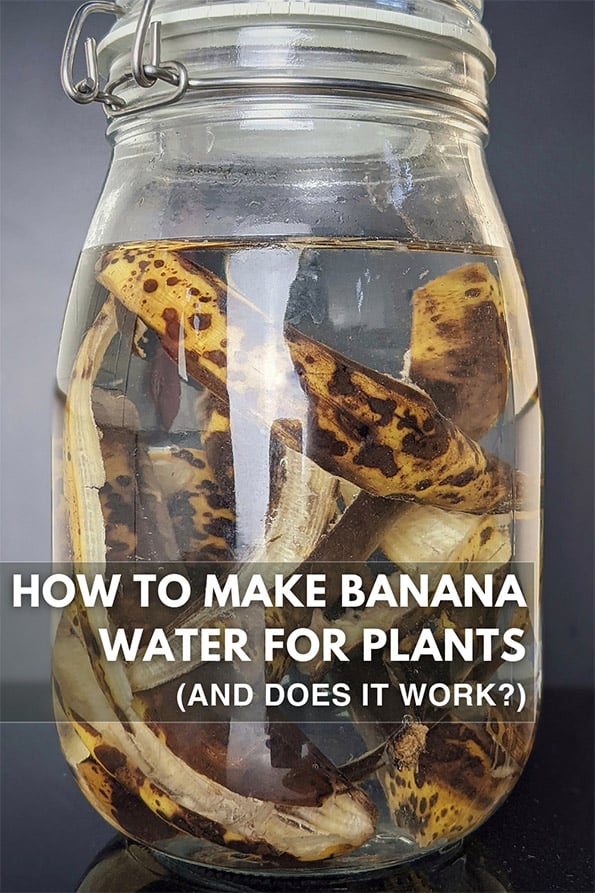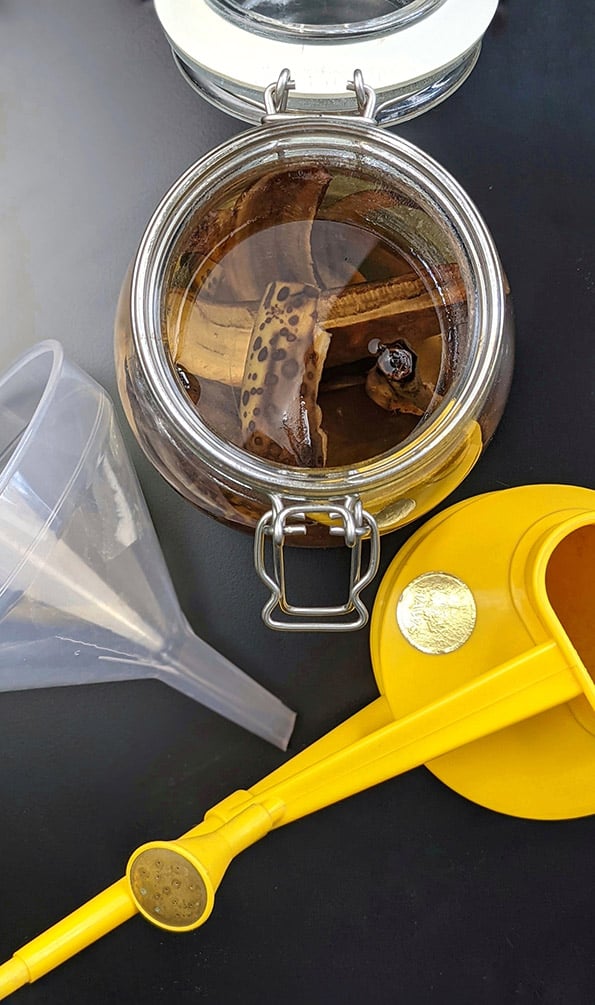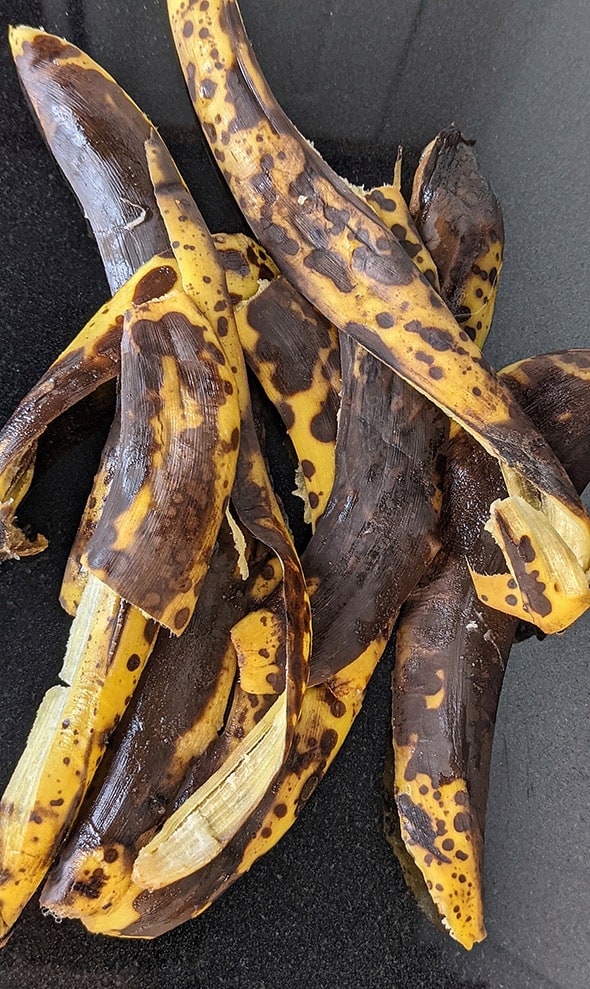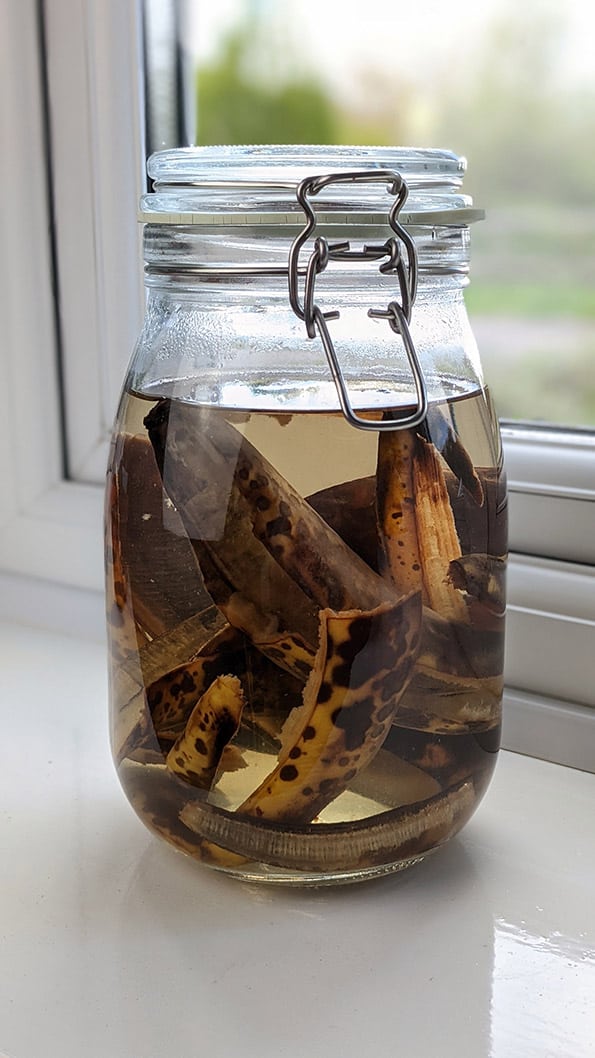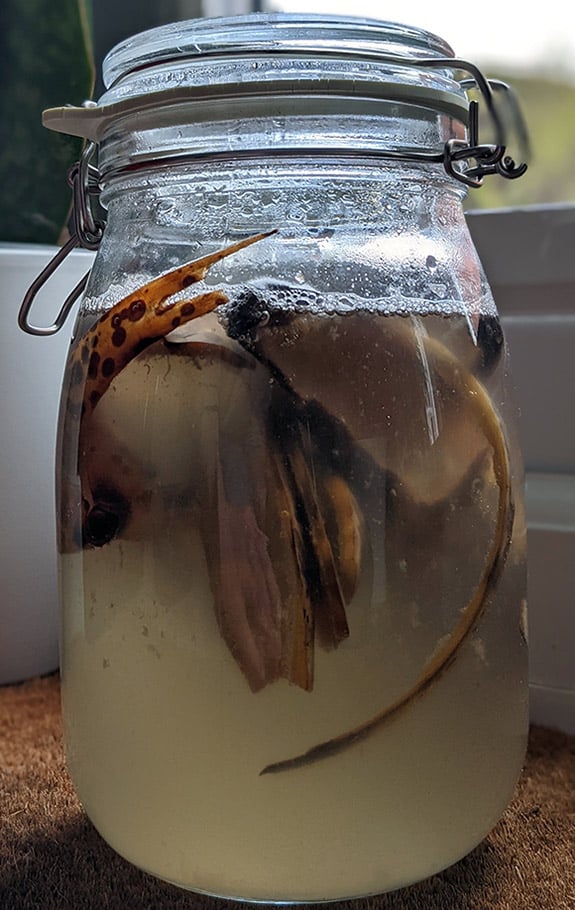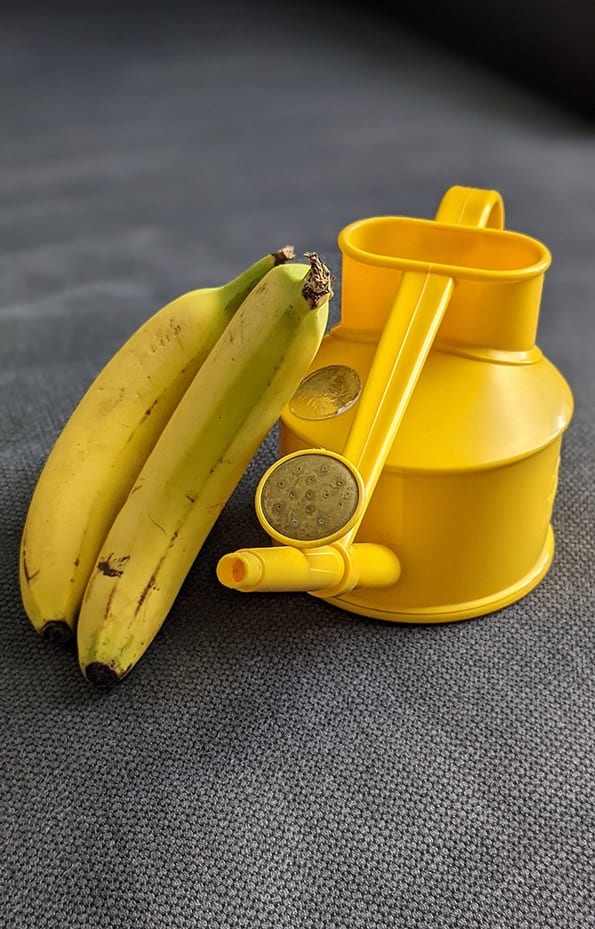Bananas are a staple in many people's diets, in fact, they're the most consumed fruit in the world. But most people tend not to use the peels for anything, and the peel can make up 30% of the whole fruit. With so many bananas being eaten, that's a lot of waste.
Wouldn't it be better if we could effectively use leftover banana peels for something useful instead of just throwing them out or using them in the garden compost pile?
Enter the DIY banana peel fertilizer, otherwise known as Banana Water.
Make your own plant food for indoor plants using Banana Skins.
The origin of the "hack" is unknown and potentially has come from several sources. For example, some scientists have experimented with peels and gardeners have successfully used Comfrey Tea for decades.
You may have heard of it already on social media, or perhaps it's a new word for you and you're investigating this homemade fertilizer for indoor plants. So let's get going.

Hi, I'm Tom!
If you're like me and enjoy the challenge of growing houseplants and getting them to thrive, then Ourhouseplants can help. This website shares my knowledge and years of growing plants and provides (hopefully) helpful advice on properly caring for your indoor plant friends.
The peel of a banana contains certain metals such as manganese, magnesium, and potassium, all needed by houseplants. So how can you get the good stuff from the peel into your plant's potting mix?
Well, a 2019 study created a nano-fertilizer blend from banana peels that boosted seed germination on the plants tested. Potentially it was this study that gave rise to the Banana Water idea.
The way the researchers created the fertilizer is too complicated and expensive for the average plant owner. So what follows is the popular recipe that people are currently using.
You don't need much to create this organic fertilizer.
*You can leave the peels for 24 hours or a few weeks. The general view is that the water will have more nutrients from the peels the longer you leave them.
When using it on your plants, carefully pour the banana water into a watering can. You can use a funnel to make it easier and stop spills.
It's important not to allow solid bits of peel in the water you'll be applying to your plants as this will transfer onto the top of the soil, which you don't want (the decomposing organic material could attract Fruit Flies or other pests).
Should I dilute it?
If it's been brewing for weeks, it will be strong. A concentrated mixture will be very brown and dark and should be diluted to one part banana water to (at least) 5 parts plain water.
To help prevent this, you can place a thin sponge / cloth over the end of the funnel, which acts like a filter, blocking solid particles from getting into the watering can.
Then you water your indoor plants (or even your outdoor plants) as usual. That's it! The decomposing peels can be thrown away at this point, but they'll do better work by adding them to a compost bin for your garden plants.
You can use it on your plants every couple of weeks. Remember to dilute the mixture if it's very concentrated (see above).
Banana Water isn't for everyone, and I go over the disadvantages of using it later on. So what other methods exist for using banana peels, and are they any better?
There are three other things you could use banana peels for.
Many plant hack videos recommend using the peel to clean dusty leaves. Often touted as organic and toxin free, it sounds like an excellent use for those used skins!
All you do is rub the slimy inside of the peel over the leaf, which will attract and pull off the dust, leaving a shine behind.
Do I Recommend It?
This idea comes from the traditional Trench Composting method.
People dig a trench outside and fill it with kitchen scraps and food waste before covering it with soil. Over several months this all breaks down.
Adapting the idea for inside use, you cut the peels into small pieces before burying them directly into your potting soil to act as a soil amendment. Eventually, the "goodness" within the skins will make its way into the soil and, ultimately, the plant.
Do I recommend this?
The peels are left to dry in the sun for a few days. You can also bake them in the oven until they go black and crispy.
You then grind the dried banana peels into a fine powder that can be sprinkled over the soil surface and gently raked in at a rate of around 1 or 2 tablespoons per pot every few months.
Do I recommend this?
So what are the benefits of using banana water for plants? One of the more critical functions of potassium in houseplants is that it helps support the transport system within the plant.
It's responsible for chemical reactions to help move both nutrients and water around to where they're needed.
What about flowering?
For a long time, it was thought that potassium was essential for getting plants to bloom. Although potassium is indeed needed to help grow fruits (after the flowers have appeared and have been fertilized) there is little evidence that potassium itself is directly responsible for starting the flowering process. Or, more importantly, that it increases the number of flowers that form.
Very few houseplants produce edible fruits, so increasing the potassium levels for this reason alone is mostly unnecessary.
Potassium deficient plants typically display yellowing leaves in a blotchy pattern (chlorosis). It's not the same as general overwatering (or sometimes underwatering) which typically causes the entire leaf to go yellow and drop off.
Chlorosis is quite rare, even in houseplants that are rarely fed. But still, something to consider.
What's slightly more common though is water stress and wilting when it gets hot or the plant gets too much sun.
Even if there is plenty of moisture in the potting mix, a lack of potassium means it's harder for the plant to shift water from around the roots to the leaves fast enough to deal with the amount of water being lost from the leaves through transpiration.
A plant with reduced levels of potassium in the potting medium is likely (especially in the longer term) to be weaker than a well fed plant.
Think of it like a human deficient in an essential mineral or vitamin. The person is functional but not feeling their best and could be less resilient and more susceptible to disease.
Plants with a mineral deficiency, can lose vigor, look unhealthy and find it harder to deal with pests. Flowering plants might also produce fewer or no blooms and as covered already, find it difficult to deal with heat.
Most plants like organic matter, and a banana fertilizer tea could be a way to give your houseplants a helpful boost if their potassium levels are low.
Generally, all plants could potentially benefit from additional potassium. It plays an important role in many plant functions from stronger and optimal growth to effective cell growth.
Essentially, it could help your plants to grow faster and stronger and give them an edge if they receive incorrect or poor care.
TL:DR - All houseplants have the potential to benefit from increased levels of potassium.
The disadvantages and weaknesses of using banana peel tea fertilizer are rarely talked about, so here's what you need to be prepared for.
Leave the peels in a mason jar for at least a week to get the best results from your homemade banana water. But remember that even in ideal situations, it won't be considered a balanced or complete fertilizer.
If those negatives don't bother you, or you can provide effective workarounds, there is nothing stopping you from pressing ahead and brewing your elixirs.
But does it work and do something for your houseplants? Let's explore that next.
There are two camps when it comes to this issue. Those who think banana water is amazing with lots of potassium that delivers vital nutrients. And those that think it's just brown tinted water that does absolutely nothing for your plants.
The camp that says it won't work is correct in their thinking when they say that minerals like potassium don't simply leach out of cells within the skins when put into normal water. Especially after only a day.
They will often draw in composting as an example, where microbes and bacteria will eat and decompose organic plant material on a microscopic level. After they've finished, they leave behind the nutrients and minerals.
The composting process takes several months and requires the microbes to be present and nearby. They don't live in tap water.
The pro banana water camp, argues that you can see the breakdown of the peels happening with your own eyes and that their plants perk up and seem healthy when the water is eventually used.
This has elements of truth.
Check the photo below of my peels in a completely sealed jar. The water is undeniably tinted with "something," and white frothy bubbles are at the surface. Decomposition is clearly underway, and the peels are breaking down.
This is what Fermenting banana peel compost tea fertilizer looks like. But is it really nutrient-rich water that contains the essential nutrients for plant growth?
With only a little research out there (currently), here's what I think.
I will level with you and say that, in my experience and opinion, banana water is certainly not the best natural fertilizer for indoor plants.
I'm not going to say don't use it. But there are better uses for banana peels (putting them on a compost heap is the main one) and more efficient ways to feed your houseplants (use a balanced fertilizer that contains everything plants need). Let me explain.
I agree the decomposing process probably does start in water, by that I mean tap water is not a preserving medium by itself.
Yellow Bananas and a Yellow Watering Can. The same color for sure, but are they are a good match to improve the health of houseplants, or would a balanced synthetic fertilizer better?
Comfrey Tea is made almost the same way and experiments have shown this water does contain nutrients. Further research is needed on banana tea, but in principle, I don't see why they wouldn't produce similar results.
So I suspect banana water contains small traces of the minerals found in the peels, i.e., manganese, magnesium, and potassium. The reason there isn't a lot is twofold.
Firstly, the decomposing process has not finished before you extract the water for use. A truly composted product means you cannot identify what you're looking at. If the stuff in the jar still looks like banana peels... They're still banana peels!
And all that potassium will still be locked away within the peel.
Don't forget, in the scientific research I mentioned before, the researchers had to go through multiple steps and use several chemicals to extract the minerals. It's more complex than just using water soaked banana peels.
You just can't use banana water to replace a good feeding routine.
Secondly, it's true bananas contain potassium, but realistically it's not a huge amount. Even in the best possible situation, you'll only get small amounts of it. So the banana water may not contain enough potassium to make a difference to plants. That means a lot of effort for not a lot of gain.
The most important reason this is not a good long-term thing is that houseplants need more than potassium to thrive.
You can't use banana tea to replace a good feeding routine, because it doesn't provide the other two macro nutrients (Nitrogen and Phosphorus) that plants need.
By all means, give banana water a go every now and again, it's easy and probably does provide a small boost. But just know that it's not sustainable long term and the overall benefit your plants will get is questionable.
